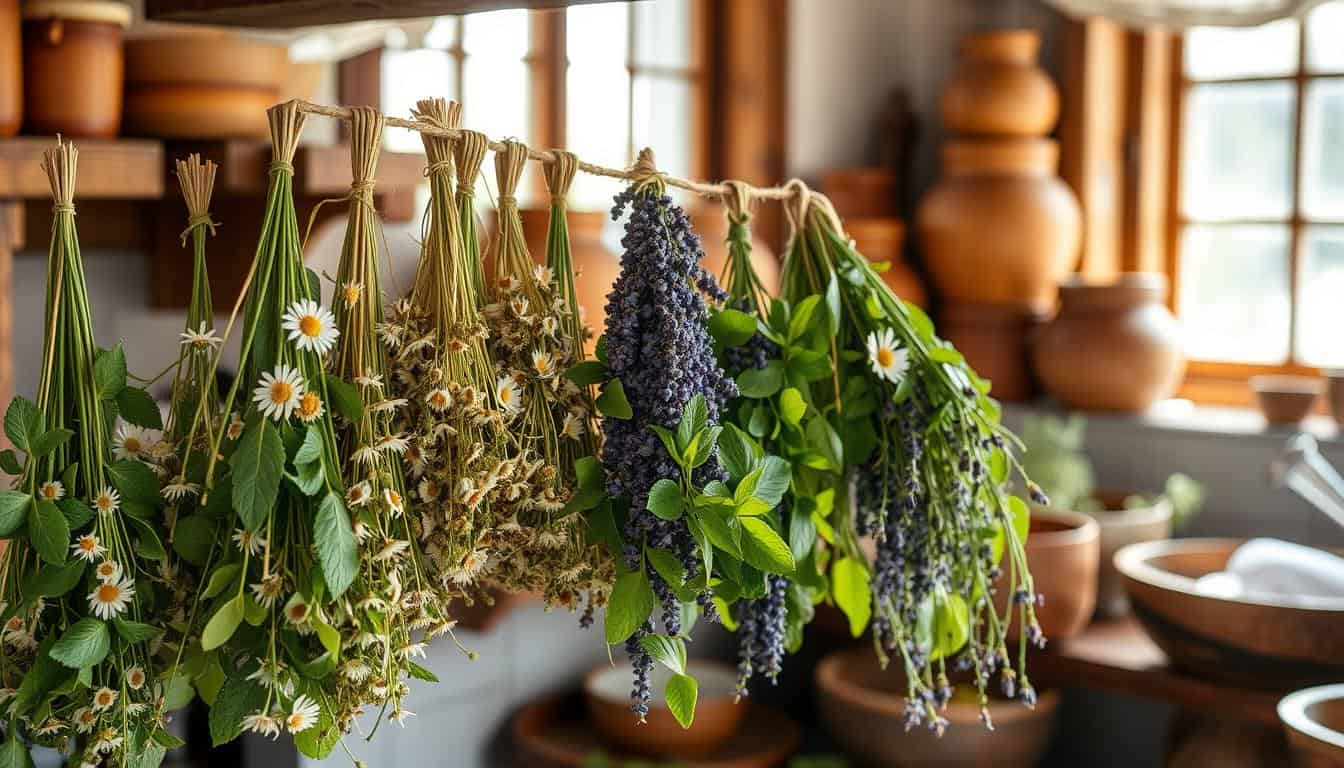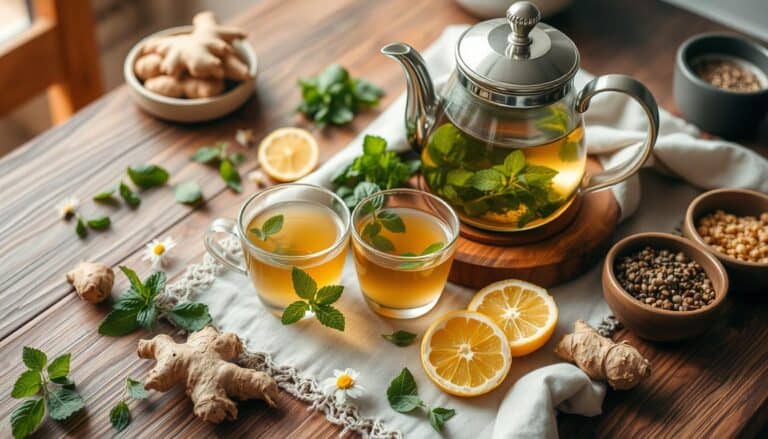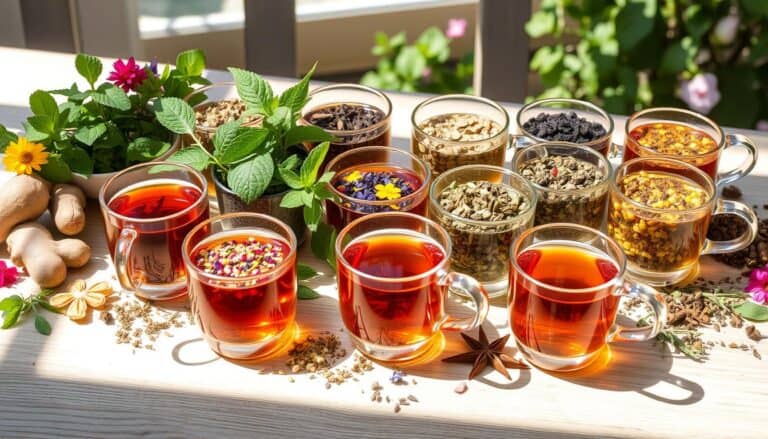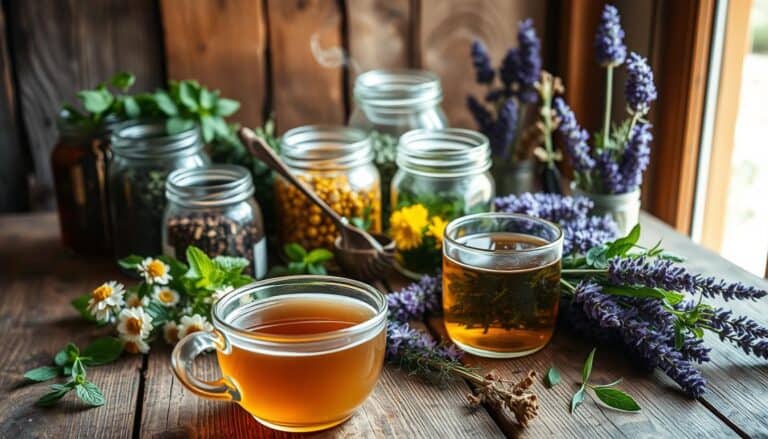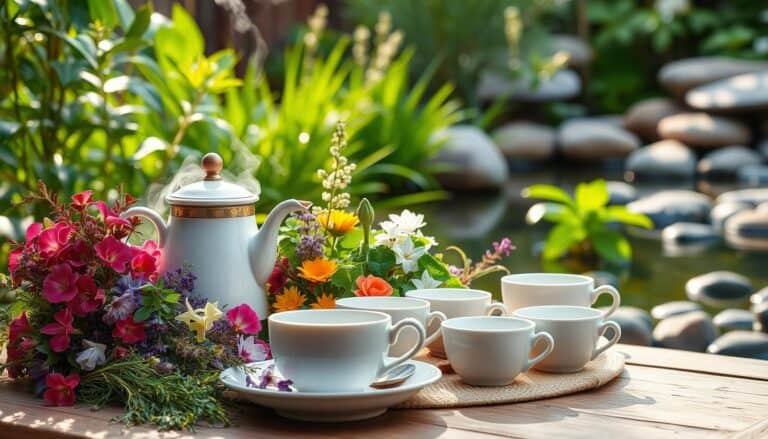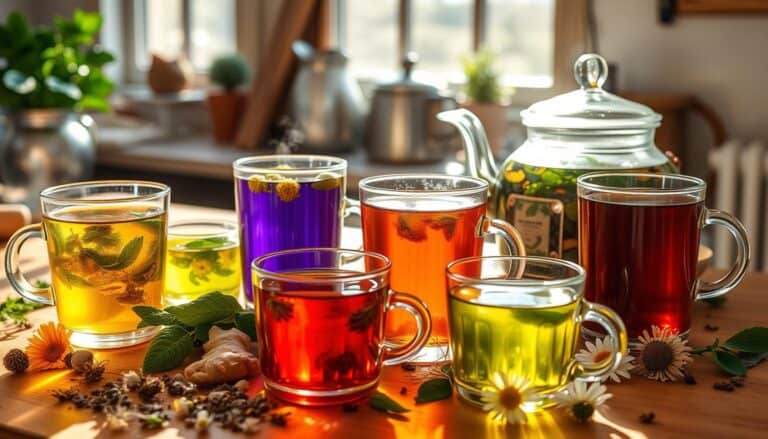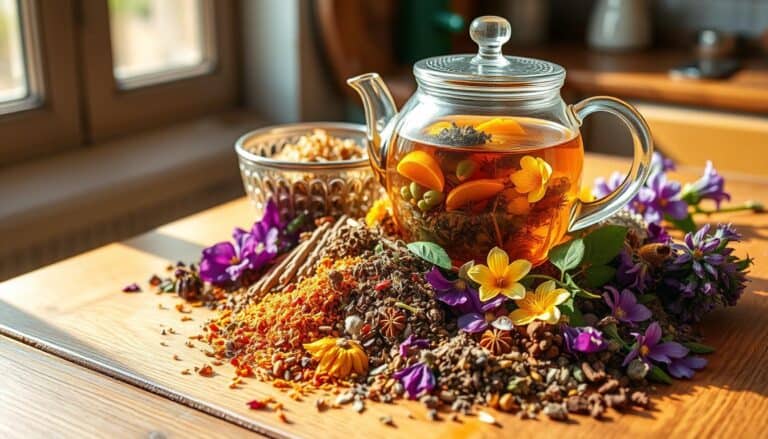Your Complete Guide to Drying Herbs for Tea
This post may contain affiliate links which means I may receive a commission for purchases made through links at no extra cost to you. I only recommend products I truly believe in. Thank you for your support!
Turning fresh herbs from your garden into tasty tea is a special art. It connects you with nature’s flavors. Drying herbs is a simple way to keep their vibrant taste alive. This lets you enjoy your favorite teas all year round.
Preserving herbal teas is more than just keeping them fresh. It’s about getting the most nutrition and flavor from your herbs. About 75-85% of tea lovers prefer dried herbs for their strong taste and ease of use.
Drying herbs saves space and time. Air-drying takes weeks, but modern methods like dehydrating can cut preparation time to 2-4 hours. Herbalists say dried herbs are three times stronger than fresh ones. This makes them perfect for making deep, flavorful teas.
Learning the basics of drying herbs will help you make delicious, healthy teas at home. Whether you’re a tea expert or just starting, knowing how to preserve herbs is key. It’s the first step to making your own tasty tea blends.
Why Drying Herbs is Essential for Tea
Turning fresh herbs into tea is a key step that brings out their best flavors. Dehydrating herbs is more than just keeping them fresh. It also makes their flavors stronger and keeps them good for longer.
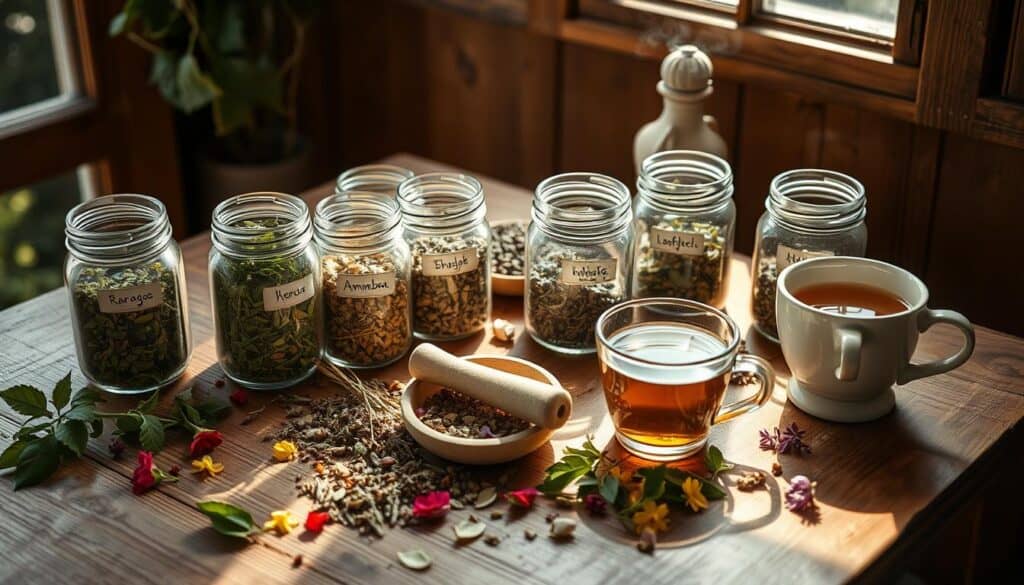
Knowing how to dry herbs is important for tea lovers. It helps them get the most out of their herbs. Let’s look at why this step is so crucial:
Benefits of Dried Herbs
- Extends herb shelf life from weeks to up to two years
- Concentrates essential oils and flavor profiles
- Provides consistent taste throughout the year
- Allows convenient storage and transportation
Difference Between Fresh and Dried Herbs
| Characteristic | Fresh Herbs | Dried Herbs |
|---|---|---|
| Shelf Life | 1-2 weeks | 1-2 years |
| Flavor Intensity | Mild | Concentrated |
| Storage Complexity | Refrigeration required | Room temperature storage |
Learning to dry herbs is key for tea lovers. It lets them make tea that tastes great all year. The drying process keeps the herbs’ good stuff, like nutrients and oils, so tea stays top-notch no matter the season.
Choosing the Right Herbs for Tea
Making homemade tea blends is an art. It mixes flavor, health benefits, and what’s in season. Knowing which herbs to use can turn your tea into a powerful wellness tool.
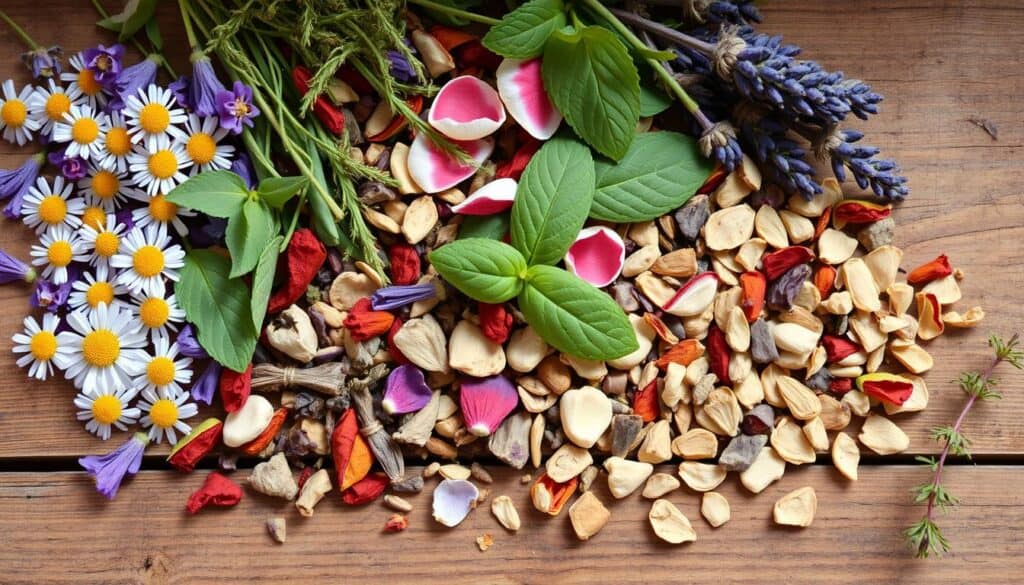
Choosing herbs for your tea is important. You need to think about taste and health benefits. Fresh herbs have 50% to 90% of a plant’s health benefits. So, picking the right ones is key for wellness.
Popular Herbs for Tea
Some herbs are great for homemade tea blends because of their amazing properties:
- Chamomile: Known for easing anxiety and helping you sleep
- Peppermint: Good for digestion and mental focus
- Holy Basil (Tulsi): Helps with stress and boosts the immune system
- Lavender: Calms and relieves tension
- Sage: Has antiseptic properties for throat health
Seasonal Considerations for Aromatic Tea Infusions
Herbs are at their best at different times. Knowing when they’re in season helps you make the best tea blends.
| Season | Recommended Herbs | Key Benefits |
|---|---|---|
| Spring | Nettle, Catnip | Detoxification, Immune Support |
| Summer | Holy Basil, Stevia | Stress Relief, Natural Sweetening |
| Autumn | Echinacea, Elderberry | Immune Boosting, Cold Prevention |
| Winter | Rosemary, Ginger | Circulation, Warmth, Digestion |
By picking herbs based on their season and benefits, you can make teas that taste great and help your health.
Best Methods for Drying Herbs
Preserving herbs’ flavor and health benefits needs careful drying. Choosing the right method greatly affects your dried herbs’ quality for tea.
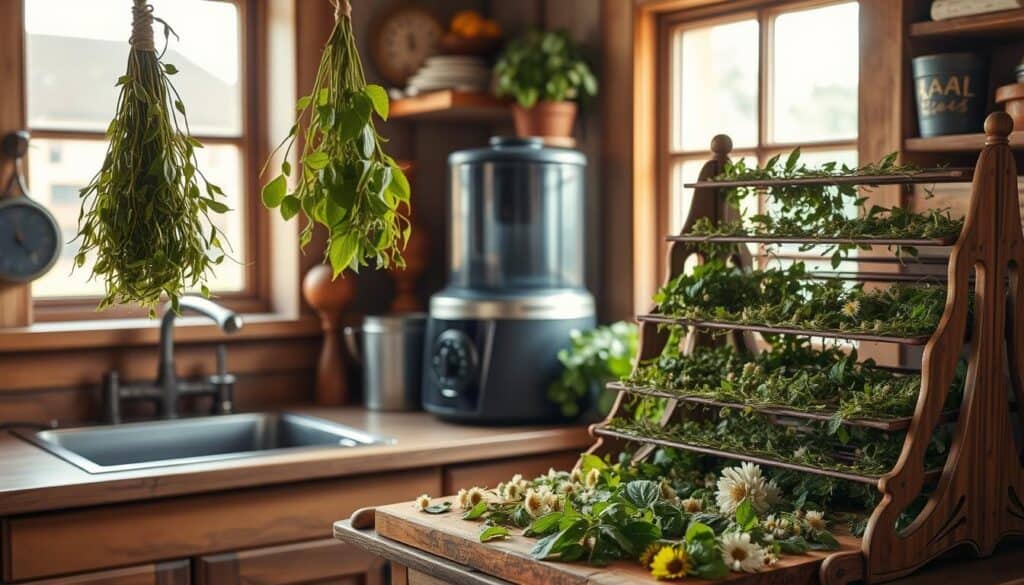
Herb lovers have many air-drying methods to pick from. Each has its own benefits for tea preparation.
Air Drying Techniques
Air-drying is a natural way to keep herbs fresh. You can:
- Hang herbs in small bunches
- Use mesh screens in well-ventilated spots
- Make sure they get indirect sunlight
Best conditions are 70-80°F with some humidity. Drying time varies from 3-7 days, based on the herb and the environment.
Oven Drying Tips
Oven drying is quicker than air-drying. Important tips include:
- Use the lowest oven setting (170°F or lower)
- Spread herbs on baking sheets
- Keep the oven door a bit open for air
Watch the herbs closely to avoid losing nutrients and keep flavor for tea.
Microwave Drying Process
Microwave drying is fast for small batches. Here’s how to do it:
- Put herbs between paper towels
- Microwave in 15-45 second bursts
- Check if they’re crispy between each burst
| Drying Method | Time Required | Best For |
|---|---|---|
| Air Drying | 3-7 days | Large herb quantities |
| Oven Drying | 2-4 hours | Small to medium batches |
| Microwave Drying | 45-90 seconds | Urgent small batches |
Pro tip: Always store dried herbs in airtight containers away from direct light to preserve their flavor and medicinal properties.
Preparing Herbs for Drying
Turning fresh herbs into tea ingredients needs careful steps. The journey to preserve herbal teas begins before drying. Knowing how to harvest and clean herbs is key to quality tea.
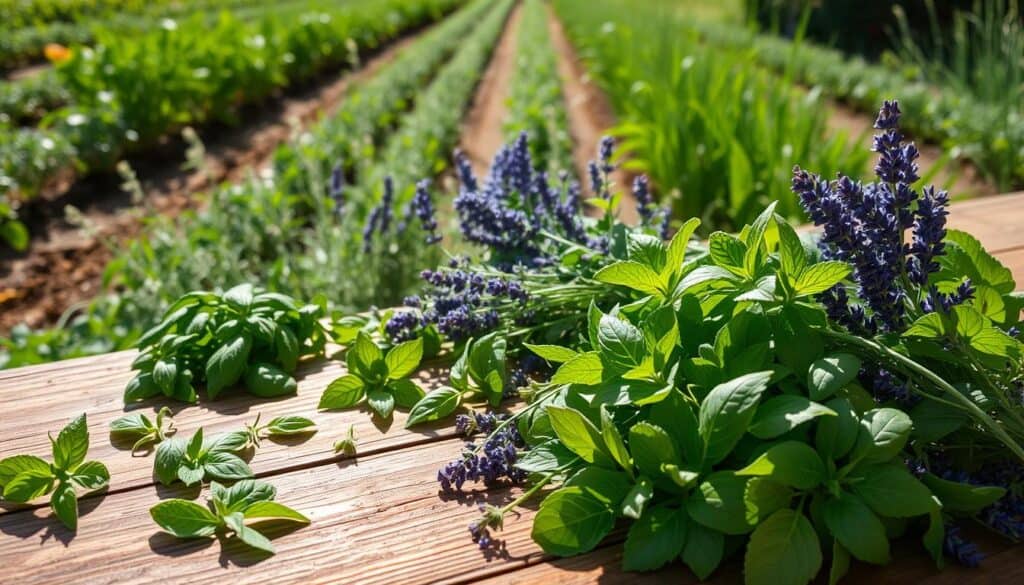
Optimal Harvesting Techniques
Timing is everything when drying herbs. Herbal experts say to harvest at the right time for the best taste and health benefits:
- Pick herbs mid-morning after morning dew has evaporated
- Choose plants that are fully leafed out and beginning to produce buds
- Avoid harvesting stressed or wilted plants
- Cut herbs just before they start flowering for maximum essential oil content
Cleaning and Preparation Methods
Cleaning herbs right is crucial for quality. Here’s how to do it:
- Gently rinse herbs in cool water
- Pay special attention to herbs with furry leaves or those growing close to the ground
- Shake herbs gently to remove excess water
- Allow herbs to air dry completely before beginning the drying process
| Herb Type | Best Harvesting Time | Cleaning Complexity |
|---|---|---|
| Mint | Mid-morning | Easy |
| Chamomile | Just before full bloom | Moderate |
| Rosemary | Dry, sunny day | Complex |
By following these steps, you’ll make great dried herbs for your tea. Remember, proper harvesting and cleaning are vital for the best flavor and health benefits in your herbal teas.
Storing Dried Herbs for Optimal Freshness
Preserving herbal teas is all about the right storage. Keeping dried herbs fresh means you get to enjoy their full flavor and health benefits.
Storing dried herbs right is key to keeping them good for a long time. The right spot can make your herbs stay fresh and tasty for months.
Ideal Storage Conditions
- Choose a cool, dark location away from direct sunlight
- Maintain consistent temperature between 60-70°F
- Keep humidity levels low to prevent mold growth
- Avoid storing near heat sources like stoves or radiators
Selecting the Right Containers
The container you choose is very important. Glass jars with tight lids are the best for keeping herbs fresh.
| Herb Type | Storage Duration | Best Container |
|---|---|---|
| Dried Leaves | 1-2 years | Amber glass jar |
| Roots and Seeds | 2-3 years | Airtight ceramic container |
| Powdered Herbs | 6-12 months | Refrigerated glass container |
Labeling and Organization
Make sure to label each container clearly. Include the herb name and date of drying. This helps you keep track of when you dried them and use them up before they lose quality.
- Use waterproof labels
- Include harvest date
- Note specific herb variety
- Consider adding origin information
By following these tips, you’ll keep your dried herbs fresh. This means you can enjoy delicious, healthy herbal teas for months.
Using Dried Herbs in Your Tea
Making homemade tea blends is an art. It turns simple dried herbs into aromatic tea infusions. Knowing the right brewing techniques can make your tea experience special.
Brewing Techniques for Perfect Herbal Tea
Mastering herbal tea brewing needs focus. Follow these steps for the perfect cup:
- Use 1-2 tablespoons of dried herbs per cup of water
- Bring water to a gentle boil
- Steep herbs for 3-5 minutes
- Use tea balls or infusers for precise brewing
- Crush dried herbs before steeping to release essential oils
Flavor Pairing Suggestions
Try mixing herbs for unique tea flavors. Here are some good combinations:
| Blend Name | Herb Combination | Potential Benefits |
|---|---|---|
| Relaxation Blend | 2 parts lemon balm, 1 part chamomile | Stress relief, promotes calm |
| Citrus Spice Blend | Lemon basil, bee balm, orange mint | Refreshing, uplifting |
| Wellness Blend | Holy basil, mint, calendula | Immune support, digestion |
When making tea blends, remember it’s all about what you like. Don’t be afraid to experiment and find your favorite herbal mix! Each blend has its own taste and health benefits.
Troubleshooting Common Drying Issues
Learning how to dry herbs well means knowing about common problems. It’s important to spot and fix these issues early to keep your herbs fresh.
Signs of bad drying include mold, color changes, and less smell. If your herbs look off or smell musty, they’re not dried right. Good air flow and the right humidity are key to avoid these problems.
Signs of Poor Drying
Keeping an eye on your herbs is crucial. If they feel wet, look limp, or change color, they’re not dry enough. Herbal experts say to check them often to keep them looking good and feeling right.
Solutions for Over- or Under-Drying
If herbs get too dry and fall apart, put them in airtight containers fast. For herbs that are still damp, keep drying them in a warm, airy place. Being patient and watching them closely helps keep your herbal teas tasty and healthy.
